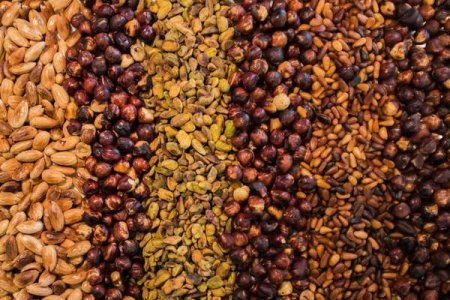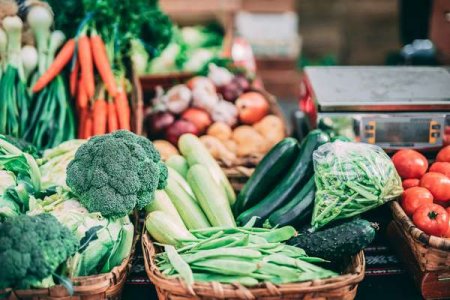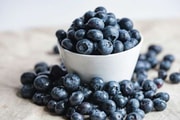You’re probably not getting enough of this diabetes-fighting nutrient
- Replies 0
Disclaimer: The information provided in this article is for educational purposes only and is not intended as a substitute for professional medical advice, diagnosis, or treatment. Always consult your physician or other qualified healthcare providers with any questions you may have regarding a medical condition or before making any changes to your health regimen.
If you’re like most at The GrayVine, you’ve probably heard the usual advice for keeping your heart and blood sugar in check: eat your veggies, get your steps in, and maybe swap that second slice of pie for a brisk walk.
But what if we told you there’s a humble, often-overlooked nutrient hiding in your pantry that could quietly help lower your risk of both heart disease and type 2 diabetes?
Meet phytosterols—the plant-based powerhouses you’ve likely been eating for years without even realizing it.
Phytosterols: The Unsung Heroes of Plant Foods
Phytosterols (sometimes called plant sterols) are natural compounds found in the cell walls of plants.
They look a lot like cholesterol, but here’s the twist: when you eat them, they actually block the absorption of cholesterol in your digestive tract. That means less “bad” LDL cholesterol floating around in your bloodstream, and a happier, healthier heart.
But the story doesn’t end there. New research presented at the American Society for Nutrition’s annual meeting in Orlando has shone a spotlight on phytosterols’ potential to do even more—specifically, to help regulate blood sugar and reduce inflammation, two key players in the development of type 2 diabetes.

The Study: Big Numbers, Big Insights
This wasn’t a small potatoes study. Researchers followed over 200,000 American adults—mostly nurses and other health professionals—for up to 36 years.
That’s a lot of lunches, dinners, and midnight snacks! Participants filled out detailed food questionnaires, and researchers analyzed their diets for total phytosterol intake, as well as three specific types: β-sitosterol, campesterol, and stigmasterol.
But they didn’t stop at food diaries. The team also collected blood samples from tens of thousands of participants, looking for markers of inflammation, insulin regulation, and overall metabolic health.
And for a select group, they even peeked into the gut microbiome—the bustling community of bacteria that lives in our digestive tracts—to see how it might interact with phytosterols.
Also read: Are you inadvertently increasing your oral cancer risk? See what shocking new research reveals about everyday habits!
What Did They Find?
The results were eye-opening. Folks who ate the most phytosterols (think: the top 20% of eaters) had a 9% lower risk of developing heart disease and an 8% lower risk of type 2 diabetes compared to those who ate the least.
That might not sound like a miracle cure, but when you consider how common these conditions are—affecting millions of Americans every year—even a single-digit drop in risk is a big deal.
But wait, there’s more! Higher phytosterol intake was linked to:
- Better insulin regulation (meaning your body handles blood sugar more smoothly)
- Lower levels of inflammation (a root cause of many chronic diseases)
- Healthier metabolic markers overall

And in the gut, certain friendly bacteria (like Faecalibacterium prausnitzii—try saying that three times fast!) seemed to help break down phytosterols, possibly boosting their benefits even further.
A Few Caveats (Because Science Is Never Simple)
Before you start sprinkling wheat germ on everything, a few words of caution. This was an observational study, so it can’t prove that phytosterols cause better health—just that they’re linked.
Most participants were health professionals, who might eat differently than the average American. And, as with any study relying on self-reported food diaries, there’s always a chance someone “forgot” about that extra cookie.
Plus, the findings haven’t yet been published in a peer-reviewed journal, so we’ll want to see more research before making any sweeping claims. Still, the evidence is promising—and it fits with what we already know about the benefits of plant-based eating.
Also read: Is this everyday nut the secret to lower cholesterol and a healthier heart? Experts reveal surprising results!
How to Get More Phytosterols (Without Breaking the Bank)
Here’s the best part: you don’t need fancy supplements or exotic superfoods to boost your phytosterol intake. These nutrients are hiding in plain sight in many everyday foods. Here’s where to find them:
- Nuts: Almonds, pistachios, walnuts—take your pick!
- Seeds: Sunflower seeds, flaxseeds, chia seeds
- Legumes: Lentils, chickpeas, black beans
- Whole grains: Oats, barley, quinoa, whole wheat bread
- Vegetable oils: Canola, sunflower, olive oil
- Fruits: Oranges, apples, avocados
- Vegetables: Broccoli, Brussels sprouts, carrots
Try tossing a handful of nuts on your morning oatmeal, adding beans to your salad, or swapping white bread for whole grain. Even small changes can add up over time.
And don’t forget, a healthy gut microbiome may help you get even more out of your phytosterols. That means eating plenty of fiber, fermented foods (like yogurt or sauerkraut), and keeping processed foods to a minimum.
Read next: Is your breakfast drink raising your risk of diabetes? New research suggests it might

Have you tried adding more plant-based foods to your diet? Noticed any changes in your energy, blood sugar, or cholesterol? Or maybe you have a favorite phytosterol-rich recipe to share? We’d love to hear your stories, tips, and questions in the comments below!
If you’re like most at The GrayVine, you’ve probably heard the usual advice for keeping your heart and blood sugar in check: eat your veggies, get your steps in, and maybe swap that second slice of pie for a brisk walk.
But what if we told you there’s a humble, often-overlooked nutrient hiding in your pantry that could quietly help lower your risk of both heart disease and type 2 diabetes?
Meet phytosterols—the plant-based powerhouses you’ve likely been eating for years without even realizing it.
Phytosterols: The Unsung Heroes of Plant Foods
Phytosterols (sometimes called plant sterols) are natural compounds found in the cell walls of plants.
They look a lot like cholesterol, but here’s the twist: when you eat them, they actually block the absorption of cholesterol in your digestive tract. That means less “bad” LDL cholesterol floating around in your bloodstream, and a happier, healthier heart.
But the story doesn’t end there. New research presented at the American Society for Nutrition’s annual meeting in Orlando has shone a spotlight on phytosterols’ potential to do even more—specifically, to help regulate blood sugar and reduce inflammation, two key players in the development of type 2 diabetes.

A large new study has linked higher intake of phytosterols—compounds naturally found in plant foods—to a reduced risk of heart disease (by 9%) and type 2 diabetes (by 8%). Image source: Peter F / Unsplash.
The Study: Big Numbers, Big Insights
This wasn’t a small potatoes study. Researchers followed over 200,000 American adults—mostly nurses and other health professionals—for up to 36 years.
That’s a lot of lunches, dinners, and midnight snacks! Participants filled out detailed food questionnaires, and researchers analyzed their diets for total phytosterol intake, as well as three specific types: β-sitosterol, campesterol, and stigmasterol.
But they didn’t stop at food diaries. The team also collected blood samples from tens of thousands of participants, looking for markers of inflammation, insulin regulation, and overall metabolic health.
And for a select group, they even peeked into the gut microbiome—the bustling community of bacteria that lives in our digestive tracts—to see how it might interact with phytosterols.
Also read: Are you inadvertently increasing your oral cancer risk? See what shocking new research reveals about everyday habits!
What Did They Find?
The results were eye-opening. Folks who ate the most phytosterols (think: the top 20% of eaters) had a 9% lower risk of developing heart disease and an 8% lower risk of type 2 diabetes compared to those who ate the least.
That might not sound like a miracle cure, but when you consider how common these conditions are—affecting millions of Americans every year—even a single-digit drop in risk is a big deal.
But wait, there’s more! Higher phytosterol intake was linked to:
- Better insulin regulation (meaning your body handles blood sugar more smoothly)
- Lower levels of inflammation (a root cause of many chronic diseases)
- Healthier metabolic markers overall

Common foods high in phytosterols include nuts, seeds, legumes, whole grains, fruits and vegetables, so incorporating these into your diet may help support better metabolic health. Image source: Iñigo De la Maza / Unsplash.
And in the gut, certain friendly bacteria (like Faecalibacterium prausnitzii—try saying that three times fast!) seemed to help break down phytosterols, possibly boosting their benefits even further.
A Few Caveats (Because Science Is Never Simple)
Before you start sprinkling wheat germ on everything, a few words of caution. This was an observational study, so it can’t prove that phytosterols cause better health—just that they’re linked.
Most participants were health professionals, who might eat differently than the average American. And, as with any study relying on self-reported food diaries, there’s always a chance someone “forgot” about that extra cookie.
Plus, the findings haven’t yet been published in a peer-reviewed journal, so we’ll want to see more research before making any sweeping claims. Still, the evidence is promising—and it fits with what we already know about the benefits of plant-based eating.
Also read: Is this everyday nut the secret to lower cholesterol and a healthier heart? Experts reveal surprising results!
How to Get More Phytosterols (Without Breaking the Bank)
Here’s the best part: you don’t need fancy supplements or exotic superfoods to boost your phytosterol intake. These nutrients are hiding in plain sight in many everyday foods. Here’s where to find them:
- Nuts: Almonds, pistachios, walnuts—take your pick!
- Seeds: Sunflower seeds, flaxseeds, chia seeds
- Legumes: Lentils, chickpeas, black beans
- Whole grains: Oats, barley, quinoa, whole wheat bread
- Vegetable oils: Canola, sunflower, olive oil
- Fruits: Oranges, apples, avocados
- Vegetables: Broccoli, Brussels sprouts, carrots
Try tossing a handful of nuts on your morning oatmeal, adding beans to your salad, or swapping white bread for whole grain. Even small changes can add up over time.
And don’t forget, a healthy gut microbiome may help you get even more out of your phytosterols. That means eating plenty of fiber, fermented foods (like yogurt or sauerkraut), and keeping processed foods to a minimum.
Read next: Is your breakfast drink raising your risk of diabetes? New research suggests it might
Key Takeaways
- A large new study has linked higher intake of phytosterols—compounds naturally found in plant foods—to a reduced risk of heart disease (by 9%) and type 2 diabetes (by 8%).
- Common foods high in phytosterols include nuts, seeds, legumes, whole grains, fruits and vegetables, so incorporating these into your diet may help support better metabolic health.
- Consuming more phytosterols was also associated with better insulin regulation and lower levels of inflammation, alongside beneficial effects on the gut microbiome.
- While the findings are promising, the study was observational, not yet peer-reviewed, and based mainly on health professionals, so more research is needed to confirm these results across the general population.
Have you tried adding more plant-based foods to your diet? Noticed any changes in your energy, blood sugar, or cholesterol? Or maybe you have a favorite phytosterol-rich recipe to share? We’d love to hear your stories, tips, and questions in the comments below!






